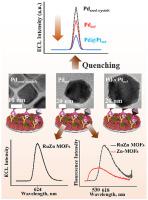Analytica Chimica Acta ( IF 5.7 ) Pub Date : 2023-03-08 , DOI: 10.1016/j.aca.2023.341076 Guanhui Zhao 1 , Yu Du 1 , Nuo Zhang 1 , Chenchen Li 1 , Hongmin Ma 1 , Dan Wu 1 , Wei Cao 1 , Yaoguang Wang 2 , Qin Wei 3

|
The successful application of electrochemiluminescence (ECL) in immunoassay for clinical diagnosis requires improving sensitivity and accuracy. Herein was reported an ECL analytical model based zinc-based metal-organic frameworks of ruthenium hybrid (RuZn MOFs) as the signal emitter. To enlarge the output difference, the quenching effect of three different noble metal nanoparticles included palladium seeds (Pdseeds), palladium octahedrons (Pdoct), and Pt-based palladium (Pd@Ptoct) core-shell were researched. Among them, Pd@Ptoct core-shell possessed higher activity and improved durability than Pd-only (NPs), they could load more protein macromolecules amicably and stabilized in the analysis system. Furthermore, since the charge redistribution owing to the hybridization of the Pt and Pd atoms in Pd@Ptoct, it could generate the electron flow maximumly from the emitter RuZn MOFs to Pd@Ptoct and result in the enhancement of quenching ECL. And the UV absorption of noble metal nanoparticles overlapped with the ECL emission of RuZn MOFs to varying degrees, which caused the behavior of resonance energy transfer (RET) reaction at the same time. This would greatly promote the sensitivity of this ECL system compared with the traditional single quenching mechanism. Based on this, a signal-off immunsensor was constructed to sensitive detection of D-dimer with linearity range from 0.001 to 200 ng mL−1, limit of detection (LOD) was 0.20 pg mL−1 and provide a further theoretical basis for the clinical application of ECL technology.
中文翻译:

用于 D-二聚体检测的基于钌杂化锌基 MOF 的电化学发光免疫分析的双猝灭机制
电化学发光 (ECL) 在临床诊断免疫测定中的成功应用需要提高灵敏度和准确性。本文报道了一种基于 ECL 分析模型的钌杂化锌基金属有机框架(RuZn MOFs)作为信号发射体。为了扩大输出差异,研究了钯晶种(Pd seeds)、钯八面体(Pd oct)和铂基钯(Pd@Pt oct )核-壳三种不同贵金属纳米粒子的淬火效果。其中,Pd@Pt oct核-壳结构比仅含钯 (NPs) 具有更高的活性和更高的耐久性,它们可以友好地加载更多的蛋白质大分子并稳定在分析系统中。此外,由于 Pd@Pt oct中 Pt 和 Pd 原子的杂化导致电荷重新分布,它可以最大程度地产生从发射极 RuZn MOF 到 Pd@Pt oct的电子流并导致猝灭ECL的增强。并且贵金属纳米粒子的紫外吸收与RuZn MOFs的ECL发射发生不同程度的重叠,同时引起共振能量转移(RET)反应行为。与传统的单一淬火机制相比,这将大大提高该 ECL 系统的灵敏度。在此基础上,构建了信号关闭免疫传感器,可灵敏检测D-二聚体,线性范围为0.001至200 ng mL -1,检测限(LOD)为0.20 pg mL -1,为进一步的理论基础提供了理论依据。 ECL技术的临床应用。











































 京公网安备 11010802027423号
京公网安备 11010802027423号